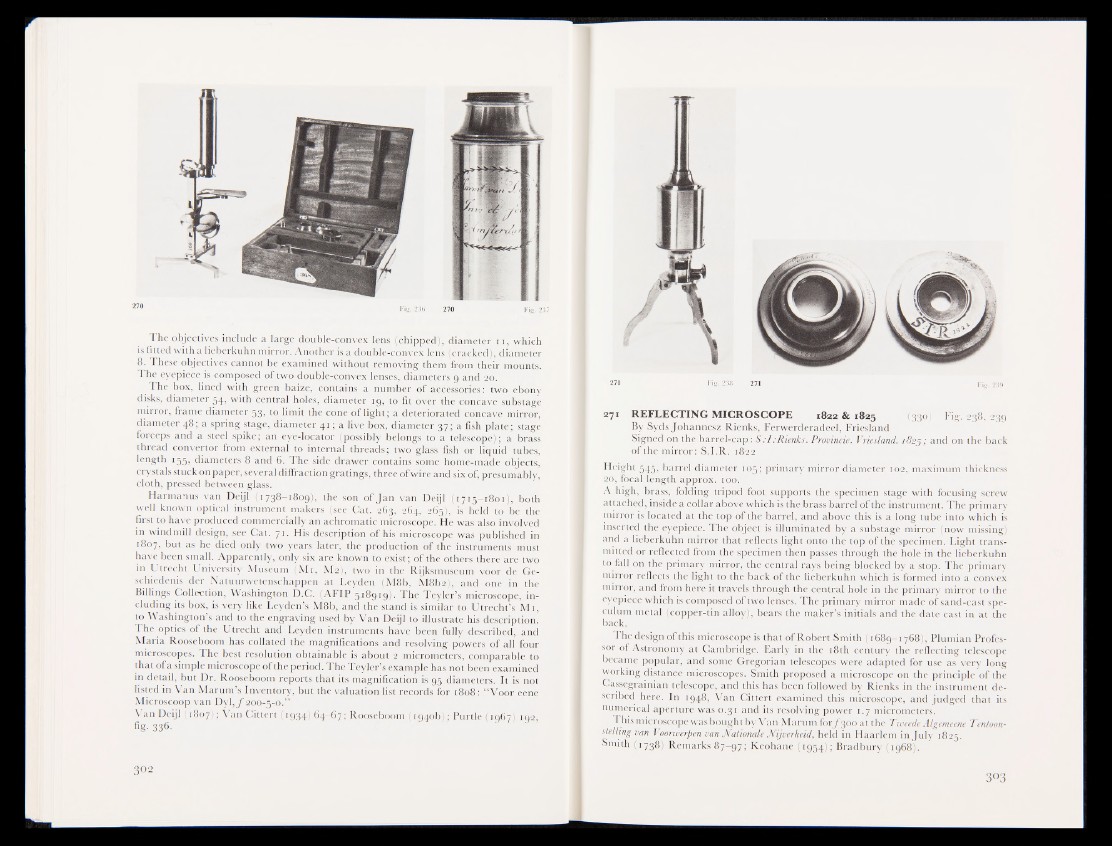
The objectives include a large double-convex lens (chipped), diameter 11, which
is fitted with a heberkuhn mirror. Another is a double-convex jflins (cracked||j diameter
8. These objectives cannot be examined without removing them from their mounts.
The eyepiece is composed of two double-convex lenses, diameters 9 and 20.'
The box, lined with green baize, contains a number of accessories ! two ebony
disks, diameter 54, with central holes, diameter ig, to fit over the concave substage
mirror, frame diameter 53, to limit the cone oflight; a deteriorated concave mirror,
diameter 48; a spring stage, diameter 41; a live box, diameter 37; a fish plate; stage
forceps and a steel spike; an eye-locator (possibly belongs to a telescope); a brass
thread convertor from external to internal threads; two glass fish or liquid tubes,
length 155; diameters 8 and 6. The side drawer contains some home-made objects,
crystals stuck on paper, several diffraction gratings, three of wire and six of, presumably,
cloth, pressed between glass.
Harmanus van Deijl (1738-1809), the son of Jan van Deijl (ipJ|-i8oi|j; both
well known optical instrument makers (see Cat. 263, 264, 265!, is held to be the
first to have produced commercially an achromatic microscope. He was also involved
in windmill design, see Cat. 71. His description of his microscope was published in
1807, but as he died only two years later, the production of the instruments must
have been small. Apparently, only six are known to exist; of the others there are two
in Utrecht University Museum (Mi, Mg), two in the Rijksmuseum voor de Geschiedenis
der Natuurwetenschappen at Leyden (M8b, M8b2), and one in the
Billings Collection, Washington D.C. (AFIP 518919). The Teyler’s microscope, including
its box, is very like Leyden’s M8b, and the stand is similar to Utrecht’s Mi,
to Washington’s and to the engraving used by Van Deijl to illustrate his description.
The optics of the Utrecht and Leyden instruments have been fully described, and
Maria Rooseboom has collated the magnifications and resolving powers of all four
microscopes. The best resolution obtainable is about 2 micrometers, comparable to
that of a sim pie microscope of the period. The T eyler’s example has not been examined
in detail, but Dr. Rooseboom reports that its magnification is 95 diameters. It is not
listed in Van Marum’s Inventory, but the valuation list records for 1808: “Voor eene
Microscoop van Dyl, ƒ 200-5-0.”
Van Deijl (1807); Van Cittert (1934) 64~f>8 Rooseboom (rg4ob)HPurtle (igfifQ 192,
fig- 336-
271 REFLECTING MICROSCOPE 1822 & 1825 (330) Fig. 238, 239
By Syds Johannesz Rienks, Ferwerderadeel, Friesland
Signed On the barrel-cap: S :I : Rienks. Provincie. Vriesland. 1825; and on the back
of the mirror: S.I.R. 1822
Height 545, barrel diameter 105 ; primary mirror diameter 102, maximum thickness
20, focal length approx, 100.
A high, brass, folding tripod foot supports the specimen stage with focusing screw
attached, inside a collar above which is the brass barrel of the instrument. The primary
mirror is located at the top of the barrel, and above this is a long tube into which is
inserted the eyepiece. The object is illuminated by a substage mirror (now missing)
and a Heberkuhn mirror that reflects light onto the top of the specimen. Light transmitted
or reflected from the specimen then passes through the hole in the Heberkuhn
to fall on the primary mirror, the central rays being blocked by a stop. The primary
mirror reflects the light to the back of the Heberkuhn which is formed into a convex
mirror, and from here it travels through the central hole in the primary mirror to the
eyepiece which is composed of two lenses. The primary mirror made of sand-cast speculum
metal |:copper-tin alloy), bears the maker’s initials and the date cast in at the
back.
The design of this microscope is that of Robert Smith (1689-1768), Plumian Professor
of Astronomy at Cambridge. Early in the 18th century the reflecting telescope
became popular, and some Gregorian telescopes were adapted for use as very long
working Ustance microscopes. Smith proposed a microscope on the principle of the
Cassegrainian telescope, and this has been followed by Rienks in the instrument described
here. In 1948, Van Cittert examined this microscope, and judged that its
numerical aperture was 0.31 and its resolving power 1.7 micrometers.
This microscope was bought by Van Marum forƒ 300 at the Tweede Algemeene Tentoonstelling
van Voorwerpen van Nationale Nijverheid, held in Haarlem in July 1825.
Smith (1738) Remarks 87-97; Keohane (1954); Bradbury (1968).